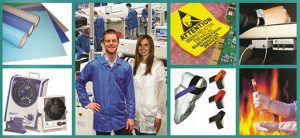ESD Training
Electrostatic discharge, or ESD, is a very real problem, especially when working with electronics. While most consumer grade products are shielded against ESD with protective cases, circuit boards, microchips and other elements are not, and a single bit of electrostatic discharge is enough to short out and destroy the entire system. This can damage these elements, if not render an entire computer system useless.
For companies, a single discharge can cost the business thousands, if not hundreds of thousands of dollars in lost material. To avoid static electricity build up, performing proper ESD removal is important. Wearing appropriate clothing and using the right tools is necessary, but you also need to know how to work inside of such an environment. It may take some slight adjusting to ensure you adhere to these ESD requirements. That is why ESD training is provided. We can make sure you know what to look for, what to avoid and how to protect yourself and your company from ESD.
The Basics
 ESD training begins with the basics. You need a solid understanding of what causes electrostatic discharge in order to learn how to avoid it and how to identify problem areas. ESD, often referred to as static electricity, is the build up of an electrical current based off of friction and resistance. Electric and hybrid vehicles use this to help generate additional electricity, yet this is not the kind of electricity you want inside of a room full of delicate electronics, chemicals, medicine and other delicate material. The ESD training covers how this static electricity builds up and why it moves from one object (yourself) to another.
ESD training begins with the basics. You need a solid understanding of what causes electrostatic discharge in order to learn how to avoid it and how to identify problem areas. ESD, often referred to as static electricity, is the build up of an electrical current based off of friction and resistance. Electric and hybrid vehicles use this to help generate additional electricity, yet this is not the kind of electricity you want inside of a room full of delicate electronics, chemicals, medicine and other delicate material. The ESD training covers how this static electricity builds up and why it moves from one object (yourself) to another.
Measurements and Precautionary Procedures
In order to determine whether or not an electrostatic current is present, it is necessary to perform precautionary procedures and measurements. During the training, you will learn how to use specific devices to measure electric currents within a given room. You can identify the source of this ESD and from there, you’ll receive instructions on how to remove it.
Understanding these precautionary tactics will make it possible for you to avoid a sudden discharge. The training will outline out to avoid electronic damage to your electronic sensitive components. You will also receive instructions on proper handling of the material you work with. This handling plays a bit role in the generating of an electrostatic current. Even if you enter a room without an electrostatic current present you can develop one due to friction, which is why proper handling techniques is important.
Grounding
 Understanding the concept of grounding is vital. When an electrostatic current is present, it wants to move to a metal object as quickly as possible. This is why you shock your hand when you touch a doorknob after walking across carpeting. Without proper grounding techniques, you run the risk of ESD not from you to a door knob, but from your hand to a microchip or another valuable device. Thankfully, you no longer need to receive a painful shock in order to make sure you don’t have an electrostatic charge present. With proper grounding equipment, you can connect yourself to a grounding point, which will send the current down to the ground point. This way, both you and the electronic sensitive equipment will avoid this shock.
Understanding the concept of grounding is vital. When an electrostatic current is present, it wants to move to a metal object as quickly as possible. This is why you shock your hand when you touch a doorknob after walking across carpeting. Without proper grounding techniques, you run the risk of ESD not from you to a door knob, but from your hand to a microchip or another valuable device. Thankfully, you no longer need to receive a painful shock in order to make sure you don’t have an electrostatic charge present. With proper grounding equipment, you can connect yourself to a grounding point, which will send the current down to the ground point. This way, both you and the electronic sensitive equipment will avoid this shock.
There are different forms of grounding available. Within ESD training you will learn about these different forms. Some are installed directly into the room, while others work as portable, individual units. The kind of grounding you need for your job will vary based on your company’s particular needs, but learning about these different kinds of grounding can prove especially beneficial.
Clothing and Matting
 Beyond grounding, you need to understand how to avoid the development of an electrostatic current. To completely do this, you need clothing free of friction. There are specific kinds of clothing designed to help prevent this friction. The clothing can do this based on the fabric used and the way it wears against your body. Depending on your setup, you may decide to wear an ESD coat, shirt, gloves or complete body suit. Whatever is right for your business, you will learn why the right clothing can protect you and what you work with. You will also learn about floor matting, what it is, how it protects against ESD and what type of matting (rubber or vinyl) is right for your particular setup.
Beyond grounding, you need to understand how to avoid the development of an electrostatic current. To completely do this, you need clothing free of friction. There are specific kinds of clothing designed to help prevent this friction. The clothing can do this based on the fabric used and the way it wears against your body. Depending on your setup, you may decide to wear an ESD coat, shirt, gloves or complete body suit. Whatever is right for your business, you will learn why the right clothing can protect you and what you work with. You will also learn about floor matting, what it is, how it protects against ESD and what type of matting (rubber or vinyl) is right for your particular setup.
When working with material that is electrostatic sensitive, you need appropriate training to understand how to avoid a static discharge. With ESD training you will learn everything from what ESD is, how an electrostatic current develops and how to protect and prevent this kind of current from developing. All of this is possible with the help of this in-depth and comprehensive training.
